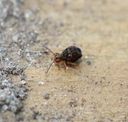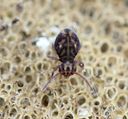Dicyrtominae
Dicyrtominae
Classification
- Phylum: Arthropoda
- Subphylum: Hexapoda
- Class: Collembola
- Order: Symphypleona
- Family: Dicyrtomidae
- Subfamily: Dicyrtominae
Pronunciation
How to pronounce Dicyrtominae: /dɪˌsaɪrtəˈmaɪniː/
These audio files are automatically generated. While they are not always 100% accurate, they are a good starting point.
Images






Summary
Dicyrtominae is a subfamily of globular springtails within the family Dicyrtomidae, comprising at least 30 described species across 3 genera. They play essential roles in ecosystem processes, primarily as decomposers.
Physical Characteristics
Globular body shape typical of springtails, often with a smooth or slightly textured cuticle.
Identification Tips
Look for the characteristic springing mechanism (furcula) and the globular shape; adults are usually small and vary in coloration.
Habitat
Found in a variety of habitats including leaf litter, soil, and decaying organic matter; often in moist environments such as forests and wetlands.
Distribution
Worldwide distribution, with a presence throughout North America.
Diet
Primarily detritivores feeding on decaying organic material, fungi, and algae.
Life Cycle
Undergoes a simple lifecycle involving egg, juvenile (nymph), and adult stages; may reproduce year-round depending on environmental conditions.
Reproduction
Most species reproduce sexually, laying eggs in moist environments; some may exhibit parthenogenesis.
Predators
May be preyed upon by larger soil arthropods, including predatory mites, beetles, and some insect larvae.
Ecosystem Role
Important decomposers in soil ecosystems, assisting in the breakdown of organic matter and nutrient cycling.
Collecting Methods
- Hand collection from leaf litter
- Soil sampling
- Using Berlese funnels for extraction
Preservation Methods
- Ethanol preservation
- Freezing specimens
- Drying specimens in a desiccator
Misconceptions
Springtails are harmless and do not pose any threat to humans or pets; they are often mistaken for pests due to their presence in moist areas.
Tags
- springtails
- Dicyrtominae
- Dicyrtomidae
- ecosystem
- soil health